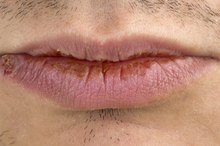How to Stop a Bleeding Tongue
The tongue is a frequently cut and injured organ because of the risk of the teeth inadvertently biting it 1. Tongue cuts typically bleed a lot because there are a lot of blood vessels in the tongue. This is because the tongue is mostly muscle and requires a lot of blood flow. Infection is also a concern because the mouth is filled with bacteria. Infection from a tongue bleed can be serious, as there are a lot of cavities where the infection can travel.
Rinse your mouth with hydrogen peroxide or another antiseptic. This step is important to prevent infection, which can lead to serious complications. Swish the antiseptic around in your mouth for a few seconds and then spit out. Then repeat with water to make sure that you do not swallow the antiseptic.
How to Heal Tongue Wounds
Learn More
Apply a cold compress to the cut area. For small tongue cuts, wrapping a few ice cubes in a paper towel will work as a cold compress. Apply steady but firm pressure for five minutes. This cold compress will help slow blood flow and speed coagulation.
Apply gentle but steady pressure for 15 to 20 minutes to the affected area, using a clean piece of gauze.
How to Care for Cuts Inside the Mouth Close to the Teeth
Learn More
If this does not stop the bleeding, go to an emergency room or urgent care center, as you may need stitches.
Related Articles
References
- Medline Plus: Tongue Problems
- Kim AM, Keenan BT, Jackson N, et al. Tongue fat and its relationship to obstructive sleep apnea. Sleep. 2014;37(10):1639–1648. Published 2014 Oct 1. doi:10.5665/sleep.4072
- Bartlett JA, van der Voort Maarschalk K. Understanding the oral mucosal absorption and resulting clinical pharmacokinetics of asenapine. AAPS PharmSciTech. 2012;13(4):1110–1115. doi:10.1208/s12249-012-9839-7
- National Organization for Rare Diseases. Tongue Cancer.
- Dotiwala AK, Samra NS. Anatomy, head and neck, tongue. [Updated 2019 Feb 8]. In: StatPearls. Treasure Island (FL): StatPearls Publishing; 2019 Jan.
- Moore KL and AF Dalley. Clinically Oriented Anatomy. Lippincott Williams & Wilkins, 4th edition, 1999, pp. 940-947.
- Stone M, et al. Structure and variability in human tongue muscle anatomy. Comput Methods Biomech Biomed Eng Imaging Vis. 2018;6(5):499–507. Published online 2016 Apr 8. doi:10.1080/21681163.2016.1162752
Writer Bio
Adam Cloe has been published in various scientific journals, including the "Journal of Biochemistry." He is currently a pathology resident at the University of Chicago. Cloe holds a Bachelor of Arts in biochemistry from Boston University, a M.D. from the University of Chicago and a Ph.D. in pathology from the University of Chicago.









